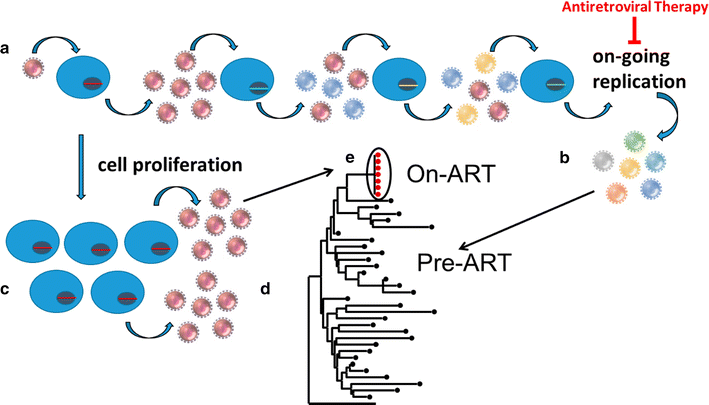HIV evolution and diversity in ART-treated patients
- PMID: 29378595
- PMCID: PMC5789667
- DOI: 10.1186/s12977-018-0395-4
HIV evolution and diversity in ART-treated patients
Abstract
Characterizing HIV genetic diversity and evolution during antiretroviral therapy (ART) provides insights into the mechanisms that maintain the viral reservoir during ART. This review describes common methods used to obtain and analyze intra-patient HIV sequence data, the accumulation of diversity prior to ART and how it is affected by suppressive ART, the debate on viral replication and evolution in the presence of ART, HIV compartmentalization across various tissues, and mechanisms for the emergence of drug resistance. It also describes how CD4+ T cells that were likely infected with latent proviruses prior to initiating treatment can proliferate before and during ART, providing a renewable source of infected cells despite therapy. Some expanded cell clones carry intact and replication-competent proviruses with a small fraction of the clonal siblings being transcriptionally active and a source for residual viremia on ART. Such cells may also be the source for viral rebound after interrupting ART. The identical viral sequences observed for many years in both the plasma and infected cells of patients on long-term ART are likely due to the proliferation of infected cells both prior to and during treatment. Studies on HIV diversity may reveal targets that can be exploited in efforts to eradicate or control the infection without ART.
Keywords: Antiretroviral therapy (ART); Expanded clones; HIV diversity; HIV genetics; HIV persistence; HIV replication; HIV reservoir.
Figures

Similar articles
-
Review: Influence of ART on HIV genetics.Curr Opin HIV AIDS. 2015 Jan;10(1):49-54. doi: 10.1097/COH.0000000000000120. Curr Opin HIV AIDS. 2015. PMID: 25389802 Free PMC article. Review.
-
Lack of concordance between residual viremia and viral variants driving de novo infection of CD4(+) T cells on ART.Retrovirology. 2016 Aug 2;13(1):51. doi: 10.1186/s12977-016-0282-9. Retrovirology. 2016. PMID: 27484989 Free PMC article.
-
Genetic Diversity, Compartmentalization, and Age of HIV Proviruses Persisting in CD4+ T Cell Subsets during Long-Term Combination Antiretroviral Therapy.J Virol. 2020 Feb 14;94(5):e01786-19. doi: 10.1128/JVI.01786-19. Print 2020 Feb 14. J Virol. 2020. PMID: 31776273 Free PMC article.
-
Intact HIV Proviruses Persist in Children Seven to Nine Years after Initiation of Antiretroviral Therapy in the First Year of Life.J Virol. 2020 Jan 31;94(4):e01519-19. doi: 10.1128/JVI.01519-19. Print 2020 Jan 31. J Virol. 2020. PMID: 31776265 Free PMC article.
-
Clonal Expansion of Infected CD4+ T Cells in People Living with HIV.Viruses. 2021 Oct 15;13(10):2078. doi: 10.3390/v13102078. Viruses. 2021. PMID: 34696507 Free PMC article. Review.
Cited by
-
Insight into treatment of HIV infection from viral dynamics models.Immunol Rev. 2018 Sep;285(1):9-25. doi: 10.1111/imr.12698. Immunol Rev. 2018. PMID: 30129208 Free PMC article. Review.
-
Dynamics of HIV DNA reservoir seeding in a cohort of superinfected Kenyan women.PLoS Pathog. 2020 Feb 5;16(2):e1008286. doi: 10.1371/journal.ppat.1008286. eCollection 2020 Feb. PLoS Pathog. 2020. PMID: 32023326 Free PMC article. Clinical Trial.
-
Empowering adolescents living with perinatally-acquired HIV: tailored CD4+ count assessment for optimized care, the EDCTP READY-study.Front Med (Lausanne). 2024 Sep 20;11:1457501. doi: 10.3389/fmed.2024.1457501. eCollection 2024. Front Med (Lausanne). 2024. PMID: 39371336 Free PMC article.
-
Predictors of Viral Non-Suppression among Patients Living with HIV under Dolutegravir in Bunia, Democratic Republic of Congo: A Prospective Cohort Study.Int J Environ Res Public Health. 2022 Jan 19;19(3):1085. doi: 10.3390/ijerph19031085. Int J Environ Res Public Health. 2022. PMID: 35162109 Free PMC article.
-
Differences in HIV Markers between Infected Individuals Treated with Different ART Regimens: Implications for the Persistence of Viral Reservoirs.Viruses. 2020 Apr 27;12(5):489. doi: 10.3390/v12050489. Viruses. 2020. PMID: 32349381 Free PMC article. Review.
References
-
- Boltz VF, Ambrose Z, Kearney MF, Shao W, Kewalramani VN, Maldarelli F, Mellors JW, Coffin JM. Ultrasensitive allele-specific PCR reveals rare preexisting drug-resistant variants and a large replicating virus population in macaques infected with a simian immunodeficiency virus containing human immunodeficiency virus reverse transcriptase. J Virol. 2012;86:12525–12530. - PMC - PubMed
Publication types
MeSH terms
Substances
Grants and funding
LinkOut - more resources
Full Text Sources
Other Literature Sources
Medical
Research Materials

